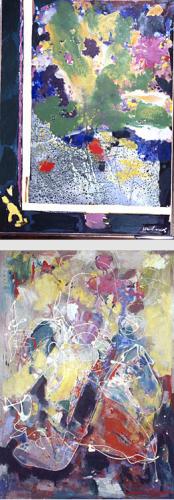Carl Heidenreich and Hans Hofmann
dal 20/5/2004 al 3/10/2004
Segnalato da
20/5/2004
Carl Heidenreich and Hans Hofmann
Berkeley Art Museum and Pacific Film Archive BAM/PFA, Berkeley
in Postwar New York. With the world's largest public collection of Hans Hofmann paintings, BAM/PFA takes an ongoing interest in exploring the effects of Hofmann's teaching on his students and colleagues. On view in the Hofmann Gallery is a selection of works by Carl Heidenreich in an exhibition that examines the work of these two German-born artists in America.

IN POSTWAR NEW YORK:
FRI MAY 21 2004 - SUN OCT 3 2004
With the world's largest public collection of Hans Hofmann paintings, BAM/PFA takes an ongoing interest in exploring the effects of Hofmann's teaching on his students and colleagues. On view in the Hofmann Gallery is a selection of works by Carl Heidenreich in an exhibition that examines the work of these two German-born artists in America. Heidenreich studied with Hofmann at the latter's Munich school in the early 1920s. Although their paths diverged in the ensuing decades, both found themselves displaced to the New World by the fascist devastation of Europe. Hofmann had the foresight to leave Germany in 1932; Heidenreich got out at the last possible moment in 1941. Heidenreich died in 1965, Hofmann in 1966.
In becoming immigrants, both men had to give up painting for long periods of time in order to earn a living. Both had to come to terms with a new balance of power in the postwar art world. In the late 1940s, both turned to abstraction. But nonrepresentational art served many purposes in the twentieth century. For some, such as Hofmann, it was an assertion of the primacy of inner vision and the liberation of the individual. In Heidenreich's case, as this exhibition illuminates, abstraction was a result of a complex negotiation with the New World.
In their sheer number, scale, and persistence, Heidenreich's paintings after 1950 form an archive of struggle, a record of a compulsive effort to overcome a trauma. They tell a tale of a German modernist used to gravity encountering the weightlessness of art life in New York; of a formerly communist, politically committed man trying to don the hat of a commercially successful artist. They tell of a man who escaped, survived, and withdrew to a kind of blindness. Whereas Hofmann turned to abstract paintings because he could see the world with great clarity, Heidenreich's abstractions represent a breakdown of the visible.
Following the committed realism of his prewar paintings, Heidenreich's first watercolor impressions of New York from the forties are somewhat estranged, detached, with the artist as an onlooker. In the following decade he proceeded to paint himself indoors, as if to mark and smear a window surface until only faint silhouettes of the outside world could be distinguished through layers of oils, gesso, and wash. There is also a strong sense of semipenetrable surface in Heidenreich's works of the 1960s painted in Mexico and Alaska. A crumbling stone wall seems to separate the artist from the outside world in the Mexican paintings, while an icy surface that neither reflects light nor lets it through stands between him and nature in the series of Alaskan watercolors.
Carl Heidenreich's art has not been publicly shown for three decades. These were decades that, above all, cherished visual exuberance, blockbuster shows, and media extravaganzas. Against this background, Heidenreich's painting was hard to see. It is difficult to penetrate because it needs to be not so much seen as read in the context of his life, the vicissitudes of twentieth-century history, and the marketplace of visual culture. The book published in conjunction with the exhibition represents the efforts of many individuals who understand and value Heidenreich's life and work in this precise constellation of contexts. The exhibition is a first step in showing Heidenreich's art so that it can be meaningfully read.
Alla Efimova
Carl Heidenreich and Hans Hofmann in Postwar New York is curated by Alla Efimova, chief curator, Judah L. Magnes Museum, formerly associate curator at the Berkeley Art Museum.
The exhibition is made possible by Richard M. Buxbaum and Catherine Hartshorn, and the Robert and Ruth Halperin Family Foundation. Additional support is provided by Gerhard and Regina Casper, Lawrence W. Stark, Elwin Marg, and Richard and Sally Goodman.
BAM/PFA
24-Hour General Information: (510) 642-0808
2626 Bancroft Way
2621 Durant Avenue
Berkeley



